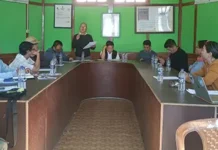[ Bengia Ajum ]
ITANAGAR, 20 Apr: Documents obtained under the Right to Information (RTI) Act have revealed that the Itanagar Wildlife Sanctuary (IWLS) has been systematically destroyed.
The documents, which were obtained by environmental activist and advocate SD Loda under the RTI Act, show that the IWLS, established through a notification issued on 14 July, 1978, exists only on paper, and the majority of the area has been encroached on.
The Environment, Forest & Climate Change Department does not even have details of the compensatory afforestation undertaken, and also there is no data on the loss of primary forest hectares. As the destruction of forests increases, there is growing fear over its impact on the water resources of the IWLS. But information obtained through RTI reveals that the government has not done any assessment of degraded water sources as of now. Also, no survey has been carried out regarding the major water sources within the boundaries of the sanctuary.
Shockingly, RTI documents reveal that the establishment of the Itanagar Municipal Corporation and the Assembly constituency within the IWLS is not legal. Further, two of the iconic buildings of Itanagar – the civil secretariat and the state Assembly – considered to be the power centre of the state, did not receive clearance for construction as they fall under the IWLS.
The documents reveal that since 1980, not a single permission or clearance has been granted for any construction within the sanctuary boundaries – yet massive construction has continued unabated.
“No environmental impact assessment reports were prepared for major constructions, and no compensatory afforestation was undertaken. Even more disturbing, there are NA (not available) entries for records of objections raised by the Wildlife Department regarding these illegal constructions, suggesting a complete abdication of responsibility by the very authorities tasked with protecting the sanctuary,” said Loda.
What makes this situation particularly tragic is that wildlife census data from 2017 and recent years show a dramatic decline in sightings. The elephant census reports from 2017, 2022, and 2023, included in the RTI response documents, show progressively fewer elephant sightings within the sanctuary, with the most recent reports showing little to no direct sightings of the large mammals that once thrived in the area.
“The sanctuary that was meant to be a haven for these threatened species has instead become a cautionary tale of conservation failure and administrative negligence,” Loda added. “Urgent intervention at the highest levels is required to halt further destruction and hold accountable those responsible for this systematic dismantling of a protected wildlife sanctuary,” he said.
The Itanagar Wildlife Sanctuary, spanning approximately 140.8 sq kms, was created to protect the rich biodiversity of the region. The RTI documents show the sanctuary’s once-rich biodiversity, as 58 species called it home and were classified as ‘threatened’ due to human encroachment.




